Page 362 of 387

�µ�µ
If your vehicle needs to be towed,
call a prof essional towing service or
organization. Never tow your vehicle
with just a rope or chain. It is very
dangerous.
The operator
loads your vehicle on the back of a
truck.
Therearetwowaystotowyour
vehicle: If , due to damage, your vehicle must
be towed with the f ront wheels on
the ground, do this:
Release the parking brake.
Shif t the transmission to neutral.
Leave the ignition switch in the
ACCESSORY (I) position so the
steering wheel does not lock.
The tow
truck uses two pivoting arms that go
under the f ront tires and lif t them of f
the ground. The rear tires remain on
the ground. With the f ront wheels on the ground,
do not tow the vehicle more than 50
miles (80 km), and keep the speed
below35mph(55km/h).
Start the engine.
Press on the brake pedal. Move
the shif t lever through all its
positions.
Leave the ignition switch in the
ACCESSORY (I) position so the
steering wheel does not lock.
Release the parking brake.
Turn of f the engine.
Shif t to D position and hold f or 5
seconds, then to N.
Manual transmission:
Automatic transmission:
Flat -bed Equipment
Wheel-lif t Equipment
T his is the best way to
transport your vehicle.
This is an acceptable
way to tow your vehicle.
Emergency T owing
348
Improper towing preparation will
damage the transmission. Follow the
above procedure exactly. If you cannot
shif t the transmission or start the
engine (automatic transmission), your
vehicle must be transported with the
f ront wheels of f the ground.
Table of Contents
Page 364 of 387
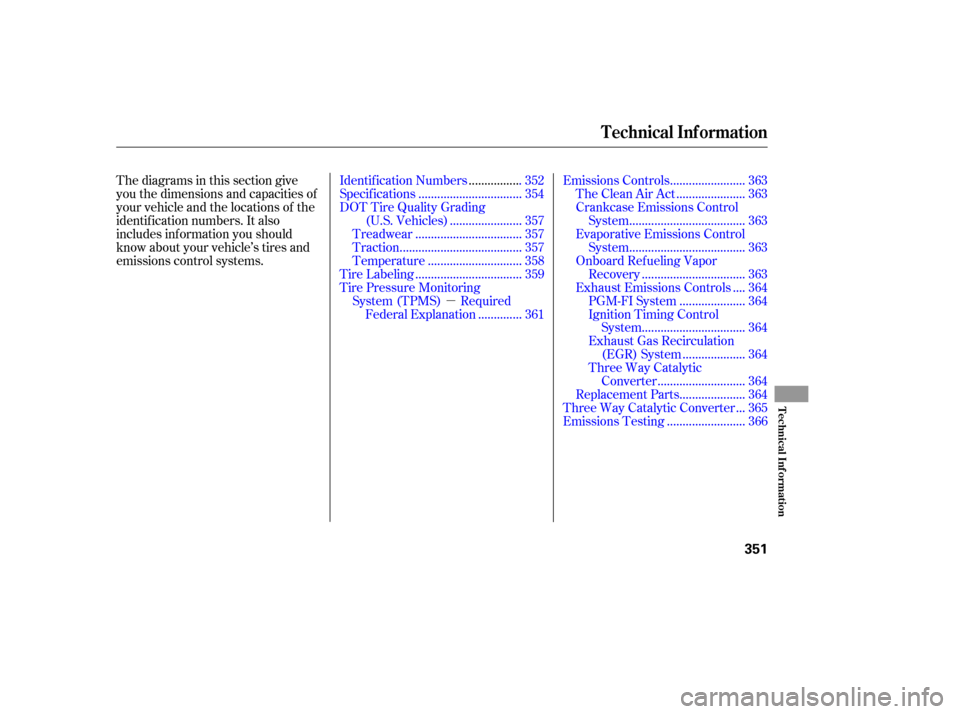
�µ
Thediagramsinthissectiongive
you the dimensions and capacities of
your vehicle and the locations of the
identif ication numbers. It also
includes inf ormation you should
know about your vehicle’s tires and
emissions control systems.
................
Identif ication Numbers . 352
................................
Specif ications . 354
DOT Tire Quality Grading
......................
(U.S. Vehicles) . 357
.................................
Treadwear . 357
......................................
Traction . 357
.............................
Temperature . 358
.................................
Tire Labeling . 359
Tire Pressure Monitoring
System (TPMS) Required .............
Federal Explanation . 361 .......................
Emissions Controls . 363
.....................
The Clean Air Act . 363
Crankcase Emissions Control
....................................
System . 363
Evaporative Emissions Control ....................................
System . 363
Onboard Ref ueling Vapor ................................
Recovery . 363
...
Exhaust Emissions Controls . 364
....................
PGM-FI System . 364
Ignition Timing Control
................................
System . 364
Exhaust Gas Recirculation ...................
(EGR) System . 364
Three Way Catalytic ...........................
Converter . 364
....................
Replacement Parts . 364
..
Three Way Catalytic Converter . 365
........................
Emissions Testing . 366
T echnical Inf ormation
T echnical Inf ormation
351
Page 369 of 387
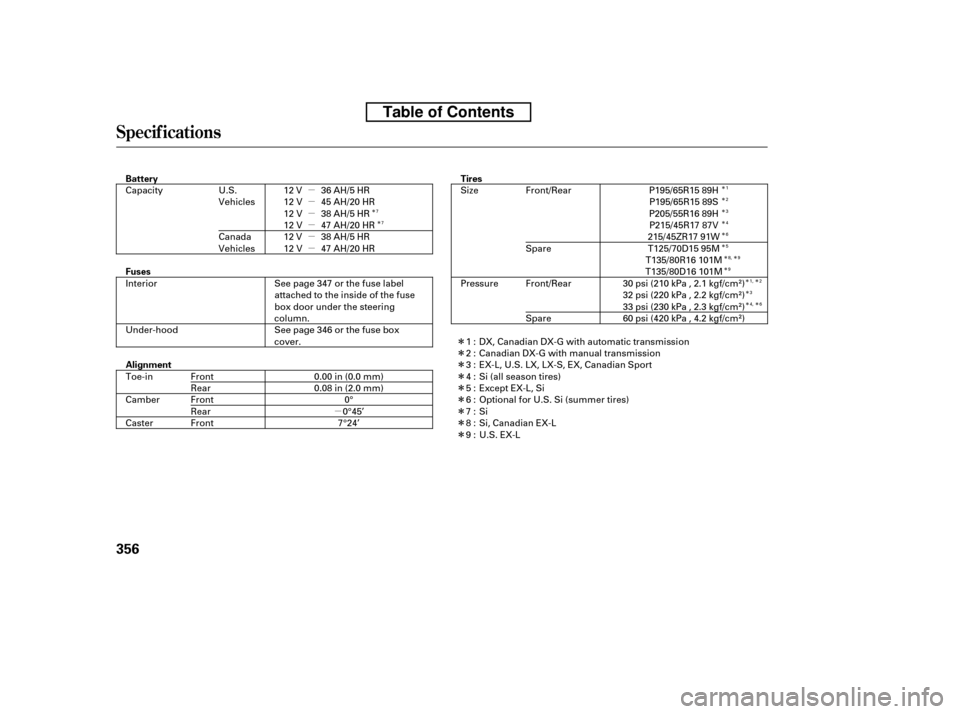
�µ
�µ �µ�µ�µ�µ�µ
�Î�Î�Î�Î�Î�Î�Î�Î�Î
�Î
�Î�Î �Î�Î
�Î
�Î �Î
�Î �Î�Î
�Î
�Î�Î
�Î�Î
Specif ications
356
Fuses
Alignment
Battery
Tires
P195/65R15 89H
Interior
Under-hood
Toe-in
Camber
Caster 7°24’0°45’
0°
0.08 in (2.0 mm)
0.00 in (0.0 mm)
Capacity 12 V
12 V
12 V36 AH/5 HR
38 AH/5 HR
45 AH/20 HR
47 AH/20 HR
12 V
12 V 38 AH/5 HR
47 AH/20 HR
12 V T135/80R16 101MT125/70D15 95M
215/45ZR17 91W P215/45R17 87V
P205/55R16 89H P195/65R15 89S
Size
Pressure
See page 347 or the fuse label
attached to the inside of the fuse
box door under the steering
column.
See page 346 or the fuse box
cover. 60 psi (420 kPa , 4.2 kgf/cm
)
33 psi (230 kPa , 2.3 kgf/cm)
32 psi (220 kPa , 2.2 kgf/cm)
30 psi (210 kPa , 2.1 kgf/cm)
T135/80D16 101M
Front Rear
FrontRear
Front Front/Rear
Spare
U.S.
Vehicles
Canada
Vehicles
Front/Rear
Spare
Si (all season tires)
Canadian DX-G with manual transmission
DX, Canadian DX-G with automatic transmission
Except EX-L, Si
EX-L, U.S. LX, LX-S, EX, Canadian Sport
1: 2:3:4:5:6:7:8:9: Optional for U.S. Si (summer tires)Si
U.S. EX-L
Si, Canadian EX-L
3
1 2 45
7
7 6
9 4, 6
3
1, 2
8, 9
Table of Contents
Page 370 of 387
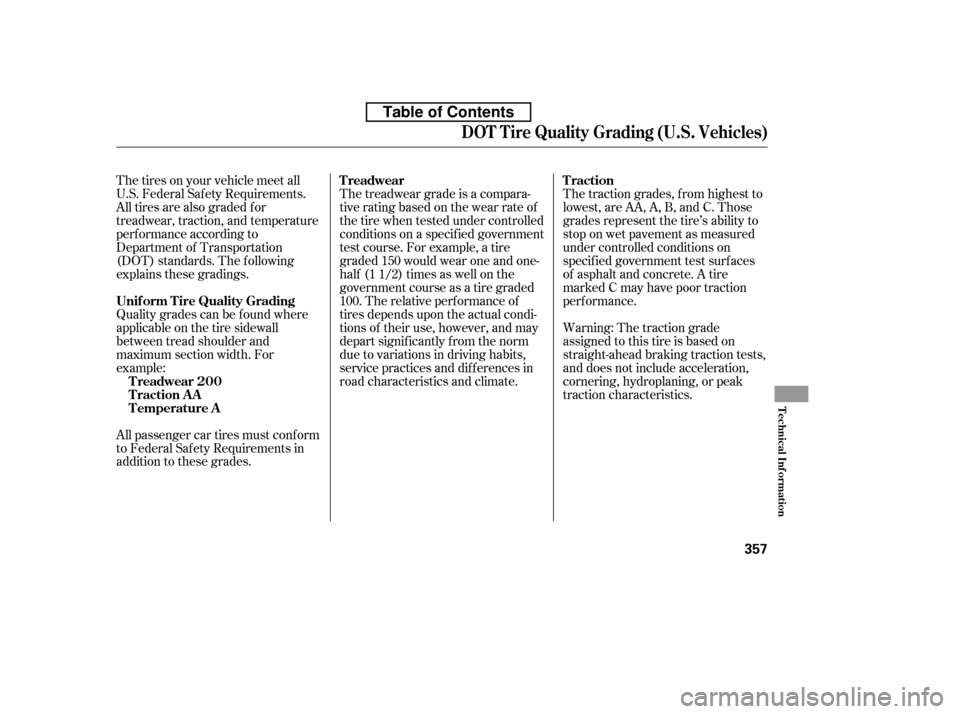
Quality grades can be f ound where
applicable on the tire sidewall
between tread shoulder and
maximum section width. For
example:
All passenger car tires must conf orm
to Federal Saf ety Requirements in
addition to these grades.The treadwear grade is a compara-
tive rating based on the wear rate of
the tire when tested under controlled
conditions on a specif ied government
test course. For example, a tire
graded 150 would wear one and one-
half (1 1/2) times as well on the
government course as a tire graded
100. The relative perf ormance of
tires depends upon the actual condi-
tions of their use, however, and may
depart signif icantly f rom the norm
due to variations in driving habits,
service practices and dif f erences in
road characteristics and climate.
The traction grades, f rom highest to
lowest, are AA, A, B, and C. Those
grades represent the tire’s ability to
stop on wet pavement as measured
under controlled conditions on
specif ied government test surf aces
of asphalt and concrete. A tire
marked C may have poor traction
perf ormance.
Warning: The traction grade
assignedtothistireisbasedon
straight-ahead braking traction tests,
and does not include acceleration,
cornering, hydroplaning, or peak
traction characteristics.
The tires on your vehicle meet all
U.S. Federal Saf ety Requirements.
All tires are also graded f or
treadwear, traction, and temperature
perf ormance according to
Department of Transportation
(DOT) standards. The f ollowing
explains these gradings.
Unif orm T ire Quality Grading
T readwear 200
Traction AA
Temperature A T readwear T raction
DOT T ire Quality Grading (U.S. Vehicles)
T echnical Inf ormation
357
Table of Contents
Page 371 of 387

Warning: The temperature grade f or
this tire is established f or a tire that
is properly inf lated and not
overloaded. Excessive speed,
underinf lation, or excessive loading,
either separately or in combination,
can cause heat buildup and possible
tire f ailure.
The temperature grades are A (the
highest), B, and C, representing the
tire’s resistance to the generation of
heat and its ability to dissipate heat
when tested under controlled
conditions on a specif ied indoor
laboratory test wheel. Sustained high
temperature can cause the material
of the tire to degenerate and reduce
tire life, and excessive temperature
can lead to sudden tire f ailure. The
grade C corresponds to a level of
perf ormance which all passenger car
tires must meet under the Federal
Motor Vehicle Saf ety Standard No.
109. Grades B and A represent
higher levels of perf ormance on the
laboratory test wheel than the
minimum required by law.
Temperature
DOT T ire Quality Grading (U.S. Vehicles)
358
Table of Contents
Page 372 of 387
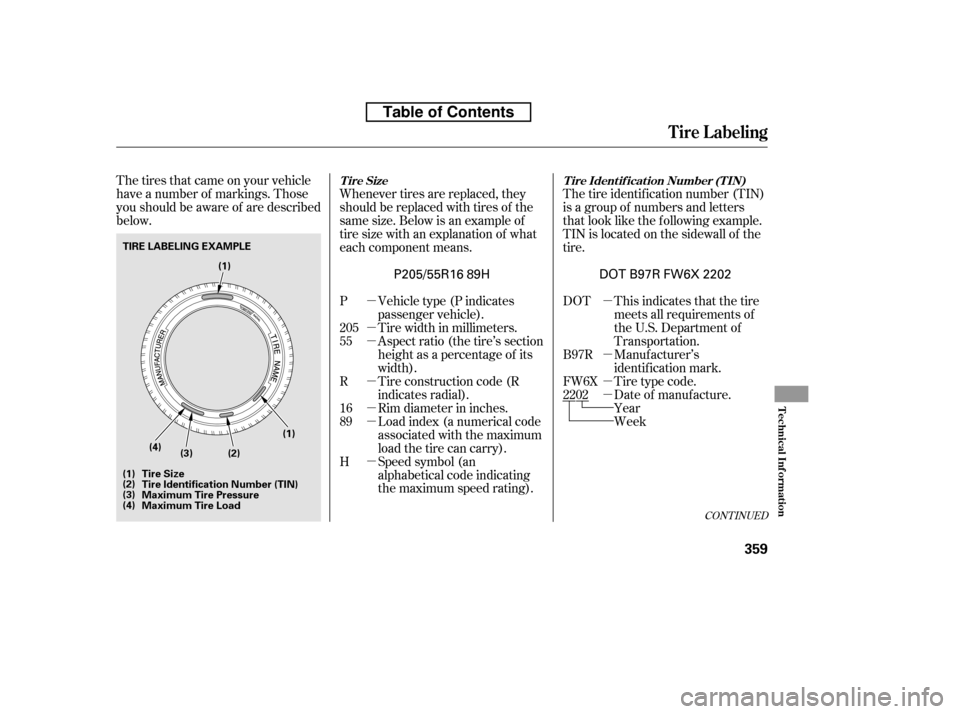
�µ �µ �µ �µ
�µ �µ �µ �µ �µ �µ �µ
The tires that came on your vehicle
have a number of markings. Those
you should be aware of are described
below.
The tire identif ication number (TIN)
is a group of numbers and letters
that look like the f ollowing example.
TIN is located on the sidewall of the
tire.
This indicates that the tire
meets all requirements of
the U.S. Department of
Transportation.
Manuf acturer’s
identification mark.
Tire type code.
Date of manuf acture.
Whenever tires are replaced, they
should be replaced with tires of the
same size. Below is an example of
tire size with an explanation of what
each component means.
Vehicletype(Pindicates
passenger vehicle).
Tire width in millimeters.
Aspect ratio (the tire’s section
height as a percentage of its
width).
Tire construction code (R
indicates radial).
Rim diameter in inches.
Load index (a numerical code
associated with the maximum
load the tire can carry).
Speed symbol (an
alphabetical code indicating
the maximum speed rating). Year
Week
P 55R 16
DOT B97R
FW6X 2202
205 89 H
CONT INUED
T ire Ident if icat ion Number (T IN)
Tire Size
Tire Labeling
T echnical Inf ormation
359
TIRE LABELING EXAMPLE
(1)
(2)
(3)
(4) Tire Size
Maximum Tire Load
Tire Identification Number (TIN)
Maximum Tire Pressure (3)
(1)
(1)
(2)
(4)
DOT B97R FW6X 2202
P205/55R16 89H
Table of Contents
Page 374 of 387
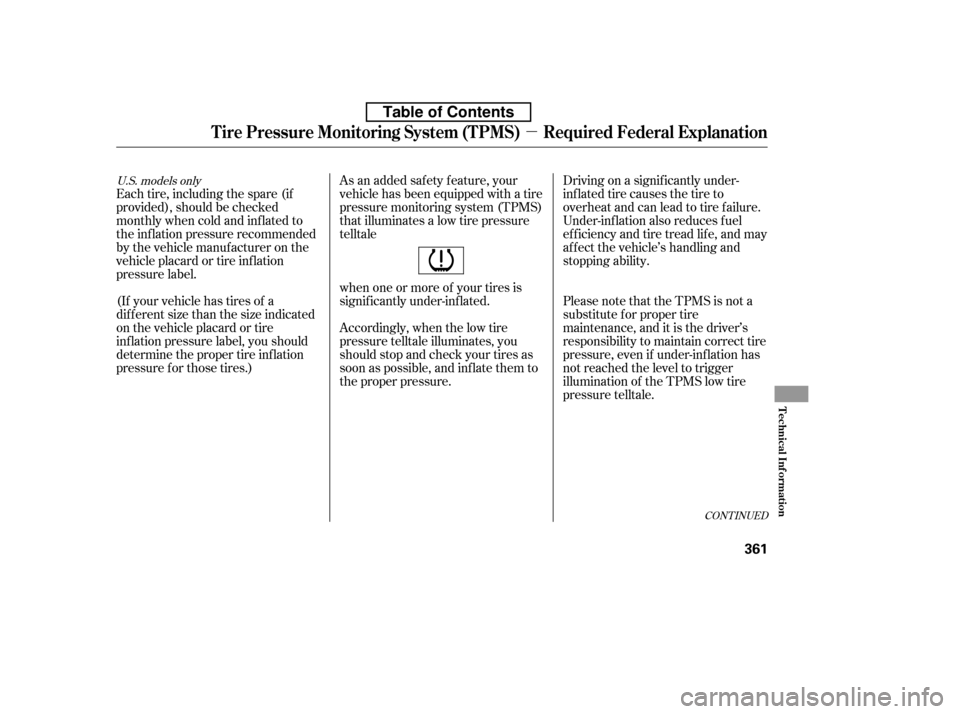
�µ
U.S. models only
Each tire, including the spare (if
provided), should be checked
monthly when cold and inf lated to
the inf lation pressure recommended
by the vehicle manuf acturer on the
vehicle placard or tire inf lation
pressure label.
(If your vehicle has tires of a
dif f erent size than the size indicated
on the vehicle placard or tire
inf lation pressure label, you should
determine the proper tire inf lation
pressure f or those tires.)As an added safety feature, your
vehicle has been equipped with a tire
pressure monitoring system (TPMS)
that illuminates a low tire pressure
telltale
when one or more of your tires is
signif icantly under-inf lated.
Accordingly, when the low tire
pressure telltale illuminates, you
should stop and check your tires as
soon as possible, and inf late them to
the proper pressure.Driving on a signif icantly under-
inf lated tire causes the tire to
overheat and can lead to tire failure.
Under-inf lation also reduces f uel
efficiency and tire tread life, and may
af f ect the vehicle’s handling and
stopping ability.
Please note that the TPMS is not a
substitute for proper tire
maintenance, and it is the driver’s
responsibility to maintain correct tire
pressure, even if under-inf lation has
not reached the level to trigger
illumination of the TPMS low tire
pressure telltale.
CONT INUED
Tire Pressure Monitoring System (TPMS) Required Federal Explanat
ion
T echnical Inf ormation
361
Table of Contents
Page 375 of 387
�µ
Your vehicle has also been equipped
with a TPMS malf unction indicator
to indicate when the system is not
operating properly. The TPMS
malf unction indicator is provided by
a separate telltale, which displays the
symbol ‘‘TPMS’’ when illuminated.
When the malf unction indicator is
illuminated,
the system may not be able to detect
or signal low tire pressure as
intended.
TPMS malf unctions may occur f or a
variety of reasons, including the
installation of replacement or
alternate tires or wheels on the
vehicle that prevent the TPMS f rom
f unctioning properly.Always check the TPMS malf unction
telltale af ter replacing one or more
tires or wheels on your vehicle to
ensure that the replacement or
alternate tires and wheels allow the
TPMS to continue to f unction
properly.
Tire Pressure Monitoring System (TPMS) Required Federal Explanat
ion
362
Table of Contents